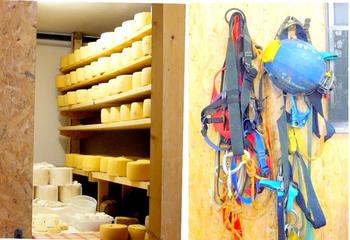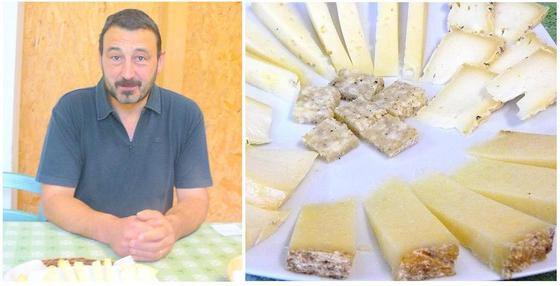Cheese maker Dario Zidaric and a plate of his cheeses. The Jamar is in the foreground.
TRIESTE, Italy--This corner of the world, where the Adriatic meets the Alps, where Italy meets Slovenia and Croatia, is full of sink-holes and limestone caves. It was also the first flashpoint of the Cold War, before the borders melted into the European Union.
On the surface, though, you see only the gray rock called karst, and you admire the perseverance of the families who plant grape vines and olive trees here. The whites include picolit, malvasia and vitovska; the red varieties go beyond cabernet sauvignon and cabernet franc to include refosco, schiopettino, and terrano. (Go ahead, tell me you've tried vitovska! On the other hand, the New York Times ran a Diner's Journal post about vitovska four years ago. So there.)
My visit here was sponsored by the Collio Carso wine consortium, but I was so taken with the cheese at Josko Sirk's La Subida the other night that we had to make a non-wine stop. It was at Dario Zidaric's farm and vineyard a few miles outside of Trieste, capital of the Friuli Venezia Giula region.
Dario is a big guy, a giant. Patient, kind, and unafraid of hard work. The perfect disposition, I'd say, for a farmer, or, for that matter, for a cheese-maker whose flagship product requires aging deep underground in a cave you have to actually descend into using serious climbing gear.
 His 90 cows give only half the milk of an industrial farm: 700 liters a day of unpasteurized organic milk (which translates to about 70 kg, 150 lbs, of cheese). He makes eight or nine different styles of cheese. The "simple" ones, like Montasio and caciotti bianchi, go to local shops via a network of cheesemongers. The more complex, like an aged caciotta covered with an indigenous herbs such as the thyme-like santoreggia, are destined for high-level restaurants across northern Italy and Austria. And then there's Jamar.
His 90 cows give only half the milk of an industrial farm: 700 liters a day of unpasteurized organic milk (which translates to about 70 kg, 150 lbs, of cheese). He makes eight or nine different styles of cheese. The "simple" ones, like Montasio and caciotti bianchi, go to local shops via a network of cheesemongers. The more complex, like an aged caciotta covered with an indigenous herbs such as the thyme-like santoreggia, are destined for high-level restaurants across northern Italy and Austria. And then there's Jamar.
The Jamar spends four months ripening in a very damp, very dark cave 250 feet underground. You don't walk in, you don't ride in, you drop down, in full spelunking gear. (By coincidence, I think, there's a cave-climbing device manufactured in Switzerland called Jumar.) Dario does this once a week, taking 100 fresh, 10-lb cheeses with him and bringing a similar number of aged cheeses back up from their makeshift shelving. The ripened Jamar has a remarkably rich, nutty flavor that resembles a cave-aged Gruyère from Switzerland or a mature Comté from the Massif Central of France, earthy and truffle-scented. Once the mold is brushed off, it will sell for 25 euros a kilo, about $17 per pound.
Dario owns the cave outright. It's on (inside?) a piece of land a mile or so from his farm, but no, I didn't go down.
Sincere thanks to the folks who hosted my trip to the region, the winemakers consortium of Collio and Carso.

Leave a comment